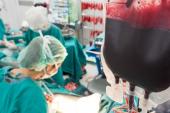Risk Stratification Before Noncardiac Surgery Won’t Catch All Myocardial Injury
Postoperative troponin testing should become more routine to identify MINS and prevent mortality, experts argue.

In patients undergoing noncardiac surgery, current tools for preoperative risk stratification do not prognosticate either postoperative troponin levels or 1-year all-cause mortality, according to new data. Notably, patients designated to be at low risk for myocardial injury preoperatively had the highest rates of mortality.
Myocardial injury after noncardiac surgery (MINS) is a key driver of death in patients undergoing lifesaving or quality-of-life-enhancing procedures. Yet the most recent American Heart Association noncardiac surgery guidelines, last updated in 2014, do not recommend routine measurement of troponins after surgery unless a patient is showing signs or symptoms of myocardial ischemia or injury.
“Our work suggests the need for prospective trials that evaluate the role of routine postoperative MINS screening (including high-sensitivity assays), even in preoperatively low-risk patients if they have cardiovascular risk factors, toward mortality risk stratification and potential risk mitigation,” write Sunil K. Vasireddi, MD (Case Western Reserve University School of Medicine, Cleveland, OH), and colleagues. “In addition to the all-cause mortality, a more-rigorous evaluation of cardiac mortality, both in the short and the long term, is warranted to better assess if risk mitigation strategies including aspirin, statin, antithrombotics, and/or further ischemia evaluations and coronary interventions improve hard outcomes in these patients.”
The results highlight the fact that any patient with myocardial injury has a poor prognosis regardless of preoperative risk, said P.J. Devereaux, MD, PhD (Population Health Research Institute, Hamilton, Canada), who was not involved with the study.
“If you don't measure troponins, you'll miss 80% plus of the events, and that's why it's important to measure it and follow these patients closely,” he commented TCTMD. “The very tragedy is that some patients are getting a cure of their cancer with surgery or getting a dramatic improvement in their quality of life with a new hip or a new knee just to use a couple of examples. Some of them are getting myocardial injury that no one knows about. No one then tries to optimize their cardiovascular risk or follows the patient, and then patients have recurrent major events and they die. That is something that we definitely need to do a better job to avoid.”
Preoperative Risk, Postoperative Events
For the study, published online last week in the Journal of the American Heart Association, Vasireddi and colleagues retrospectively reviewed the charts of 548 patients aged 40-80 years who had troponin I levels drawn within 14 days after noncardiac surgery requiring an overnight hospital stay at their institution. All participants had a minimum of two cardiovascular risk factors but did not report trauma, pulmonary embolism, or neurosurgery.
Overall, 69% and 31% of the population were classified as low and high risk, respectively, per the Revised Cardiac Risk Index (RCRI) and 66% and 34% per the American College of Surgeons National Surgical Quality Improvement Program (NSQIP). However, preoperative risk assessment was not associated with either postoperative troponin elevation or 1-year mortality when low-risk patients were compared with those at high risk.
Unsurprisingly, MINS was linked to an almost fourfold increase in the risk of 1-year mortality (OR 3.9; 95% CI 2.44-6.33). Notably, though, patients classified as low risk preoperatively were at the highest risk of 1-year mortality (OR 9.6; 95% CI 4.27-24.38), with only up to 35% on statins. Patients with elevated postoperative troponins were 5.8 times more likely to die from cardiovascular causes compared with those without (P < 0.001).
Also, patients who had a postoperative troponin elevation and those who did not reported no differences in the prevalence of cardiovascular risk factors. “This suggests that while cardiovascular risk factors might be useful to screen patients at a higher risk for postoperative myocardial injury and mortality, these risk factors by themselves do not adequately identify the patients specifically at risk for MINS or long-term mortality,” the authors write.
The findings overall indicate “that our current preoperative risk stratification tools such as RCRI and NSQIP do not adequately capture the mortality risk specifically in the long term,” they say. “There is then a need for improving risk-stratification tools specifically for predicting long-term mortality in these patients, and such a tool will likely benefit from using postoperative troponin for discrimination of risk.”
‘Deserves More Attention’
The results showing that patients who report MINS have a poor prognosis did not surprise Devereaux. What this adds, though, is that “patients who have low revised cardiac risk index scores or other clinical scores prior to surgery, who then have a troponin elevation afterwards, are also on a very bad trajectory. That's a very important observation,” he said. “That group, which most people I don't think would be thinking of, needs and deserves more attention to figure out how to manage them appropriately.”
Devereaux guessed that “most centers don’t routinely measure troponins after surgery” for a variety of reasons, most related to habit and lack of guidelines compelling the practice. “People have the events when they're in the first 24-36 hours after surgery when they are postanesthetic and they are getting narcotics, and they just don't experience symptoms. But if you don't know that, then you can't even think forward to ‘what might I do to improve their intermediate to long-term cardiovascular risk?’ . . . There's a big missed opportunity.”
It’s likely that clinicians are already starting to make proactive changes to look more closely for MINS, “but it's studies like this [that] hopefully will continue to push it in the right direction,” he continued. “We need more patients after surgery having their troponin measured and then we need more perioperative care physicians to be engaged with those patients and be getting them on the right long-term medication. We need also more trials on how do you optimally manage patients that get myocardial injury. But even in the short term, some basic prophylactic measures like aspirin and statins seem like a relatively obvious and intuitive thing given the current evidence that we have.”
Yael L. Maxwell is Senior Medical Journalist for TCTMD and Section Editor of TCTMD's Fellows Forum. She served as the inaugural…
Read Full BioSources
Vasireddi SK, Pivato E, Soltero-Mariscal E, et al. Postoperative myocardial injury in patients classified as low risk preoperatively is associated with a particularly increased risk of long-term mortality after noncardiac surgery. J Am Heart Assoc. 2021;10:e019379.
Disclosures
- Vasireddy, Kondapaneni, and Devereaux report no relevant conflicts of interest.





Comments